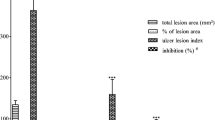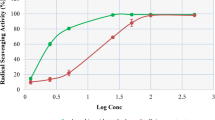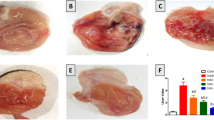Abstract
Chlorogenic acid (CGA) is found in many foods, including coffee, berries, potatoes, carrots, wine, apples, and various herbs, and has anti-inflammatory, antidiabetic, and antitumoral actions. The CGA is well absorbed orally, and its effects on gastric ulcer have not been previously reported. The present manuscript evaluated the effect of oral administration of CGA on ethanol/HCl (Et/HCl) or nonsteroidal anti-inflammatory drug (NSAID)-induced gastric ulcer model in male Swiss mice. Animals were pretreated with 0.2 % carboxymethylcellulose (vehicle, p.o.), omeprazole (positive control, 30 mg/kg, p.o.), carbenoxolone (antioxidant positive control, 100 mg/kg, p.o.), or CGA (5, 25, or 50 mg/kg, p.o.). One hour later, the gastric ulcer was induced by injecting Et/HCl solution (100 μL/10 g body weight; Et 60 % + HCl 0.03 M) or piroxicam (100 mg/kg, p.o). After another hour or 4 h later, gastric tissues were collected from Et/HCl or piroxicam-treated animals, respectively, to evaluate the size of the lesion, histological alterations, secretion of gastric acid, neutrophil migration, oxidative/antioxidative enzymes, markers of lipid peroxidation, or concentrations of inflammatory mediators. CGA treatment had a gastroprotective effect in both models, reducing the percentage of lesioned area. CGA treatment did not alter the secretion of gastric action but inhibited neutrophil migration and restored the levels of catalase, superoxide dismutase, glutathione peroxidase, glutathione, and thiobarbituric acid reactive substances in mice treated with Et/HCl. Additionally, CGA treatment blocked the increase of tumor necrosis factor alpha and leukotriene B4 but did not restore the reduced prostaglandin levels in the NSAID-induced ulcer. Together, the data presented herein show that CGA may be a suitable natural compound for the prevention and treatment of gastric lesions caused by a different etiology.






Similar content being viewed by others
References
Aly AM, Al-Alousi L, Salem HA (2005) Licorice: a possible anti-inflammatory and anti-ulcer drug. AAPS Pharm Sci Technol 6:74–82
Andrade-Cetto A, Vázquez RC (2010) Gluconeogenesis inhibition and phytochemical composition of two Cecropia species. J Ethnopharmacol 130:93–97
Barocelli E, Chiavarini M, Ballabeni V, Barlocco D, Vianello P, Dal Piaz V, Impicciatore M (1997) Study of the antisecretory and antiulcer mechanisms of a new indenopirydazinone derivative in rats. Pharmacol Res 35:487–492
Baron JH (1977) Effect of carbenoxolone sodium on human gastric acid secretion. Gut 18:21–722
Beserra AM, Calegari PI, Souza MD, dos Santos RA, Lima JC, Silva RM, Balogun SO, Martins DT (2011) Gastroprotective and ulcer healing mechanisms of ellagic acid in experimental rats. J Agric Food Chem 13:6957–6965
Beutler E (1975) Red cell metabolism: a manual of biochemical methods, 2nd edn. Grune & Stratton, New York, pp 89–90
Bonita JS, Mandarano M, Shuta D, Vinson J (2007) Coffee and cardiovascular disease: in vitro, cellular, animal, and human studies. Pharmacol Res 55:187–198
Bradley PP, Priebat DA, Christensen RD, Rothstein G (1982) Measurement of cutaneous inflammation: estimation of neutrophil content with an enzyme marker. J Investig Dermatol 78:206–209
Brzozowski T, Konturek PC, Sliwowski Z, Kwiecie S, Drozdowicz D, Pawlik M, Mach K, Konturek SJ, Pawlik WW (2006) Interaction of nonsteroidal anti-inflammatory drugs (NSAID) with Helicobacter pylori in the stomach of humans and experimental animals. J Physiol Pharmacol 57:67–79
Chen ZY, Peng C, Jiao R, Wong YM, Yang N, Huang Y (2009) Anti-hypertensive nutraceuticals and functional foods. J Agric Food Chem 57:4485–4499
De Maria CAB, Trugo LC, De Mariz e Miranda LS (1999) The content of individual caffeoylquinic acids in edible vegetables. J Food Compos Anal 12:289–292
De Oliveira RB, de Paula DA, Rocha BA, Franco JJ, Gobbo-Neto L, Uyemura SA, dos Santos WF, Da Costa FB (2011) Renal toxicity caused by oral use of medicinal plants: the yacon example. J Ethnopharmacol 133:434–441
De Souza Almeida ES, Filho VC, Niero R, Clasen BK, Balogun SO, de Oliveira Martins DT (2011) Pharmacological mechanisms underlying the anti-ulcer activity of methanol extract and canthin-6-one of Simaba ferruginea A. St-Hil. in animal models. J Ethnopharmacol 134:630–636
Dos Santos MD, Almeida MC, Lopes NP, de Souza GE (2006) Evaluation of the anti-inflammatory, analgesic and antipyretic activities of the natural polyphenol chlorogenic acid. Biol Pharm Bull 29:2236–2240
Dragstedt LR, Woodward ER, Linares CA, Delarosa C (1964) The pathogenesis of gastric ulcer. Ann Surg 160:497–511
Eklund A (1975) Effect of chlorogenic acid in a casein diet for rats. Nutritional and pathological observations. Nutr Metab 18:258–264
Farah A, Monteiro M, Donangelo CM, Lafay S (2008) Chlorogenic acids from green coffee extract are highly bioavailable in humans. J Nutr 138:2309–2315
Green CE, Pearson DN, Christensen NB, Simon SI (2003) Topographic requirements and dynamics of signaling via l-selectin on neutrophils. Am J Physiol Cell Physiol 284:C705–C717
Green CE, Pearson DN, Camphausen RT, Staunton DE, Simon SI (2004) Shear-dependent capping of l-selectin and P-selectin glycoprotein ligand 1 by E-selectin signals activation of high-avidity beta2-integrin on neutrophils. J Immunol 172:7780–7790
Guslandi M (1987) Effect of ethanol on the gastric mucosa. Dig Dis 5:21–32
Hebeda CB, Bolonheis SM, Nakasato A, Belinati K, Souza PD, Gouvea DR, Lopes NP, Farsky SH (2011) Effects of chlorogenic acid on neutrophil locomotion functions in response to inflammatory stimulus. J Ethnopharmacol 135:261–269
Hoelzl C, Knasmüller S, Wagner KH, Elbling L, Huber W, Kager N, Ferk F, Ehrlich V, Nersesyan A, Neubauer O, Desmarchelier A, Marin-Kuan M, Delatour T, Verguet C, Bezençon C, Besson A, Grathwohl D, Simic T, Kundi M, Schilter B, Cavin C (2010) Instant coffee with high chlorogenic acid levels protects humans against oxidative damage of macromolecules. Mol Nutr Food Res 54:1722–1733
Hwang YP, Yun HJ, Chun HK, Chung YC, Kim HK, Jeong MH, Yoon TR, Jeong HG (2009) Protective mechanisms of 3-caffeoyl, 4-dihydrocaffeoyl quinic acid from Salicornia herbacea against tert-butyl hydroperoxide-induced oxidative damage. Chem Biol Interact 181:366–376
Ishida K, Kojima R, Tsuboi M, Tsuda Y, Ito M (2010) Effects of artichoke leaf extract on acute gastric mucosal injury in rats. Biol Pharm Bull 33:223–229
Kempf K, Herder C, Erlund I, Kolb H, Martin S, Carstensen M, Koenig W, Sundvall J, Bidel S, Kuha S, Tuomilehto J (2010) Effects of coffee consumption on subclinical inflammation and other risk factors for type 2 diabetes: a clinical trial. Am J Clin Nutr 91:950–957
Kim YS, Kim NH, Lee YM, Kim JS (2011) Preventive effect of chlorogenic acid on lens opacity and cytotoxicity in human lens epithelial cells. Biol Pharm Bull 34:925–928
Kirchner T, Aparicio B, Argentieri DC, Lau CY, Ritchie DM (1997) Effects of tepoxalin, a dual inhibitor of cyclooxygenase/5-lipoxygenase, on events associated with NSAID-induced gastrointestinal inflammation. Prostaglandins Leukot Essent Fat Acids 56:417–423
Kitagawa S, Yoshii K, Morita SY, Teraoka R (2011) Efficient topical delivery of chlorogenic acid by an oil-in-water microemulsion to protect skin against UV-induced damage. Chem Pharm Bull (Tokyo) 59:793–796
Klein LC Jr, Gandolfi RB, Santin JR, Lemos M, Cechinel Filho V, de Andrade SF (2010) Antiulcerogenic activity of extract, fractions, and some compounds obtained from Polygala cyparissias St. Hillaire & Moquin (Polygalaceae). Naunyn Schmiedeberg’s Arch Pharmacol 381:121–126
Krakauer T (2002) The polyphenol chlorogenic acid inhibits staphylococcal exotoxin-induced inflammatory cytokines and chemokines. Immunopharmacol Immunotoxicol 24:113–119
Kujbida P, Hatanaka E, Campa A, Curi R, Farsky SHP, Pinto E (2008) Analysis of chemokines and reactive oxygen species formation by rat and human neutrophils induced by microcystin-LA, -YR and -LR. Toxicon 51:1274–1280
Lakshmi V, Singh N, Shrivastva S, Mishra SK, Dharmani P, Mishra V, Palit G (2010) Gedunin and photogedunin of Xylocarpus granatum show significant anti-secretory effects and protect the gastric mucosa of peptic ulcer in rats. Phytomedicine 17:569–574
Lemos M, Santin JR, Júnior LC, Niero R, Andrade SF (2011) Gastroprotective activity of hydroalcoholic extract obtained from the leaves of Brassica oleracea var. acephala DC in different animal models. J Ethnopharmacol 138:503–507
Lockrey G, Lim L (2011) Peptic ulcer disease in older people. J Pharm Pract Res 41:58–61
Malfertheiner P, Chan FKL, McColl KEL (2009) Peptic ulcer disease. Lancet 374:1449–1461
Marrassini C, Acevedo C, Miño J, Ferraro G, Gorzalczany S (2010) Evaluation of antinociceptive, anti-inflammatory activities and phytochemical analysis of aerial parts of Urtica urens L. Phytother Res 24:1807–1812
McCord JM, Fridovich I (1969) Superoxide dismutase. An enzyme function for erythrhrocuprein (hemocuprein). J Biol Chem 244:6049–6055
Medeiros JV, Gadelha GG, Lima SJ, Garcia JA, Soares PM, Santos AA, Brito GA, Ribeiro RA, Souza MH (2008) Role of the NO/cGMP/K(ATP) pathway in the protective effects of sildenafil against ethanol-induced gastric damage in rats. Br J Pharmacol 153:721–727
Mizui T, Doteuchi M (1983) Effect of polyamines on acidified ethanol-induced gastric lesion in rats. Jpn J Pharmacol 33:939–945
Naik Y, Jayaram S, Nayaka Harish MA, Lakshman, Dharmesh SM (2007) Gastroprotective effect of swallow root (Decalepis hamiltonii) extract: possible involvement of H+-K+-ATPase inhibition and antioxidative mechanism. J Ethnopharmacol 112:173–179
Nanjundaiah SM, Annaiah HN, M Dharmesh S (2009) Gastroprotective effect of ginger rhizome (Zingiber officinale) extract: role of gallic acid and cinnamic acid in H+, K+-ATPase/H. pylori inhibition and anti-oxidative mechanism. Evid Based Complement Alternat Med Jul 1
Nardini M, D'Aquino M, Tomassi G, Gentili V, Di Felice M, Scaccini C (1995) Inhibition of human low-density lipoprotein oxidation by caffeic acid and other hydroxycinnamic acid derivatives. Free Radic Biol Med 19:541–552
Ohkawa H, Ohishi N, Yagi K (1979) Assay of lipid peroxides in animal tissues by thiobarbituric acid reaction. Anal Biochem 95:351–358
Olmos A, Giner RM, Recio MC, Rios JL, Cerdá-Nicolás JM, Máñez S (2007) Effects of plant alkylphenols on cytokine production, tyrosine nitration and inflammatory damage in the efferent phase of contact hypersensitivity. Br J Pharmacol 152:366–373
Olthof MR, Hollman PC, Katan MB (2001) Chlorogenic acid and caffeic acid are absorbed in humans. J Nutr 131:66–71
Peters-Golden M, Canetti C, Mancuso P, Coffey MJ (2004) Leukotrienes: underappreciated mediators of innate immune responses. J Immunol 174:589–594
Puangpraphant S, Berhow MA, Vermillion K, Potts G, Gonzalez de Mejia E (2011) Dicaffeoylquinic acids in yerba mate (Ilex paraguariensis St. Hilaire) inhibit NF-κB nucleus translocation in macrophages and induce apoptosis by activating caspases-8 and -3 in human colon cancer cells. Mol Nutr Food Res 55:1509–1522
Rainsford KD (1978) Gastric ulcerogenicity of non-steroidal anti-inflammatory drugs in mice with mucosa sensitized by cholinomimetic treatment. J Pharm Pharmacol 39:669–672
Ribeiro AL, Shimada AL, Hebeda CB, de Oliveira TF, de Melo Loureiro AP, Filho Wdos R, Santos AM, de Lima WT, Farsky SH (2011) In vivo hydroquinone exposure alters circulating neutrophil activities and impairs LPS-induced lung inflammation in mice. Toxicology 288:1–7
Santin JR, Lemos M, Klein-Júnior LC, Machado ID, Costa P, de Oliveira AP, Tilia C, de Souza JP, de Sousa JP, Bastos JK, de Andrade SF (2011) Gastroprotective activity of essential oil of the Syzygium aromaticum and its major component eugenol in different animal models. Naunyn Schmiedeberg’s Arch Pharmacol 383:149–158
Shan J, Fu J, Zhao Z, Kong X, Huang H, Luo L, Yin Z (2009) Chlorogenic acid inhibits lipopolysaccharide-induced cyclooxygenase-2 expression in RAW264.7 cells through suppressing NF-kappaB and JNK/AP-1 activation. Int Immunopharmacol 9:1042–1048
Shay H, Komarov SA, Fels SS, Meranze D, Gruenstein M, Siplet H (1945) A simple method for the uniform production of gastric ulceration in the rat. Gastroenterology 5:43–61
Sheen E, Triadafilopoulos G (2011) Adverse effects of long-term proton pump inhibitor therapy. Dig Dis Sci 56:931–950
Sies H, Koch OR, Martino E, Boveris A (1979) Increased biliary glutathione disulfide release in chronically ethanol-treated rats. FEBS Lett 103:287–290
Stalmach A, Steiling H, Williamson G, Crozier A (2010) Bioavailability of chlorogenic acids following acute ingestion of coffee by humans with an ileostomy. Arch Biochem Biophys 501:98–105
Szabo S (1987) Mechanisms of mucosal injury in the stomach and duodenum: time-sequence analysis of morphologic, functional, biochemical and histochemical studies. Scand J Gastroenterol Suppl 127:21–28
Tietze F (1969) Enzymic method for quantitative determination of nanogram amounts of total and oxidized glutathione: applications to mammalian blood and other tissues. Anal Biochem 27:502–522
Wallace JL (2008) Prostaglandins, NSAIDs, and gastric mucosal protection: why doesn’t the stomach digest itself? Physiol Rev 88:1547–1565
Xu Y, Chen J, Yu X, Tao W, Jiang F, Yin Z, Liu C (2010) Protective effects of chlorogenic acid on acute hepatotoxicity induced by lipopolysaccharide in mice. Inflamm Res 59:871–877
Yonathan M, Asres K, Assefa A, Bucar F (2006) In vivo anti-inflammatory and anti-nociceptive activities of Cheilanthes farinosa. J Ethnopharmacol 108:462–470
Yun N, Kang JW, Lee SM (2011) Protective effects of chlorogenic acid against ischemia/reperfusion injury in rat liver: molecular evidence of its antioxidant and anti-inflammatory properties. J Nutr Biochem 23(10):1249–1255
Zhang X, Huang H, Yang T, Ye Y, Shan J, Yin Z, Luo L (2010) Chlorogenic acid protects mice against lipopolysaccharide-induced acute lung injury. Injury 41:746–752
Zhao Z, Shin HS, Satsu H, Totsuka M, Shimizu M (2008) 5-caffeoylquinic acid and caffeic acid down-regulate the oxidative stress and TNF-alpha-induced secretion of interleukin-8 from Caco-2 cells. J Agric Food Chem 56:3863–3868
Acknowledgments
The authors thank FAPESP for financial support (grant nos. 2010/18069-9 and 2011/01848-8). Sandra H. P. Farsky and Jorge Mancini-Filho are fellows of the Conselho Nacional de Pesquisa e Tecnologia (CNPq); André T. Shimoyama is undergraduate fellow of FAPESP. Isabel D. Machado and José Roberto Santin are graduate fellows of FAPESP.
Author information
Authors and Affiliations
Corresponding author
Rights and permissions
About this article
Cite this article
Shimoyama, A.T., Santin, J.R., Machado, I.D. et al. Antiulcerogenic activity of chlorogenic acid in different models of gastric ulcer. Naunyn-Schmiedeberg's Arch Pharmacol 386, 5–14 (2013). https://doi.org/10.1007/s00210-012-0807-2
Received:
Accepted:
Published:
Issue Date:
DOI: https://doi.org/10.1007/s00210-012-0807-2




